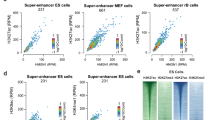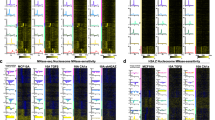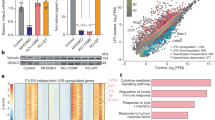Abstract
We present here an in vivo view of major histocompatibility complex (MHC) class II promoter assembly, nucleosome modifications and gene expression mediated by the class II transactivator (CIITA). Acetylation and deacetylation of histones H3 and H4 at the HLA-DRA promoter were found to occur during a time-course that depended on CIITA expression and binding. Expression of a CIITA mutant, which lacked the activation domain, induced H4 but not H3 histone acetylation. This suggested that multiple histone acetyltransferase activities are associated with MHC class II expression. H4 acetylation was mapped to Lys8, which implicated several histone acetyltransferases as possible modulators of this activity.
This is a preview of subscription content, access via your institution
Access options
Subscribe to this journal
Receive 12 print issues and online access
$209.00 per year
only $17.42 per issue
Buy this article
- Purchase on Springer Link
- Instant access to full article PDF
Prices may be subject to local taxes which are calculated during checkout






Similar content being viewed by others
References
Boss, J. M. A common set of factors control the expression of the MHC class II, invariant chain, and HLA-DM genes. Microbes Infect. 1, 847–853 (1999).
Reith, W., Muhlethaler-Mottet, A., Masternak, K., Villard, J. & Mach, B. The molecular basis of MHC class II deficiency and transcriptional control of MHC class II gene expression. Microbes Infect. 1, 839–846 (2000).
Steimle, V., Otten, L. A., Zufferey, M. & Mach, B. Complementation cloning of an MHC class II transactivator mutated in hereditary MHC class II deficiency (or bare lymphocyte syndrome). Cell 75, 135–146 (1993).
Wright, K. L., Moore, T. L., Vilen, B. J., Brown, A. M. & Ting, J. P.-Y. Major histocompatibility complex class II-associated invariant chain gene expression is up-regulated by cooperative interactions of Sp1 and NF-Y. J. Biol. Chem. 270, 20978–20986 (1995).
Westerheide, S. D., Louis-Plence, P., Ping, D., He, X.-F. & Boss, J. M. HLA-DMA and HLA-DMB gene expression functions through the conserved S-X-Y region. J. Immunol. 158, 4812–4821 (1997).
Radley, E., Alderton, R. P., Kelly, A., Trowsdale, J. & Beck, S. Genomic organization of HLA-DMA and HLA-DMB. J. Biol. Chem. 269, 18834–18838 (1994).
Martin, B. K. et al. Induction of MHC class I expression by the MHC class II transactivator CIITA. Immunity 6, 581–600 (1997).
Gobin, S. J. P., Peijnenburg, A., Keijsers, V. & van den Elsen, P. J. Site α is crucial for two routes of IFN-γ-induced MHC class I transactivation: The ISRE-mediate route and a novel pathway involving CIITA. Immunity 6, 601–611 (1997).
Griscelli, C., Lisowska-Grospierre, B. & Mach, B. Combined immunodeficiency with defective expression in MHC class II genes. Immunodeficiency Rev. 1, 135–153 (1989).
Benichou, B. & Strominger, J. L. Class II-antigen-negative patient and mutant B-cell lines represent at least three, and probably four, distinct genetic defects defined by complementation analysis. Proc. Natl Acad. Sci. USA 88, 4285–4288 (1991).
Seidl, C., Saraiya, C., Osterweil, Z., Fu, Y. P. & Lee, J. S. Genetic complexity of regulatory mutants defective for HLA class II expression. J. Immunol. 148, 1576–1584 (1992).
Nagarajan, U. M. et al. RFX-B is the gene responsible for the most common cause of the bare lymphocyte syndrome, a MHC class II immunodeficiency. Immunity 10, 153–162 (1999).
Masternak, K. et al. A gene encoding a novel RFX-associated transactivator is mutated in the majority of MHC class II deficiency patients. Nature Genet. 20, 273–277 (1998).
Steimle, V. et al. A novel DNA-binding regulatory factor is mutated in primary MHC class II deficiency (bare lymphocyte syndrome). Genes Dev. 9, 1021–1032 (1995).
Durand, B. et al. RFXAP, a novel subunit of the RFX DNA binding complex, is mutated in MHC class II deficiency. EMBO J. 16, 1045–1055 (1997).
Silacci, P., Mottet, A., Steimle, V., Reith, W. & Mach, B. Developmental extinction of major histocompatibility complex class II gene expression in plasmocytes is mediated by silencing of the transactivator gene CIITA. J. Exp. Med. 180, 1329–1336 (1994).
Chang, C.-H., Fodor, W. L. & Flavell, R. A. Reactivation of a major histocompatibility complex class II gene in mouse plasmacytoma cells and mouse T cells. J. Exp. Med. 176, 1465–1469 (1992).
Steimle, V., Siegrist, C.-A., Mottet, A., Lisowska-Grospierre, B. & Mach, B. Regulation of MHC class II expression by interferon-γ mediated by the transactivator gene CIITA. Science 265, 106–108 (1994).
Chang, C.-H., Fontes, J. D., Peterlin, B. M. & Flavell, R. A. Class II transactivator (CIITA) is sufficient for the inducible expression of major histocompatibility complex class II genes. J. Exp. Med. 180, 1367–1374 (1994).
Riley, J. L., Westerheide, S. D., Price, J. A., Brown, J. A. & Boss, J. M. Activation of class II MHC genes requires both the X box region and the class II transactivator (CIITA). Immunity 2, 533–543 (1995).
Mahanta, S. K., Scholl, T., Yang, F.-C. & Strominger, J. L. Transactivation by CIITA, the type II bare lymphocyte syndrome-associated factor, requires participation of multiple regions of the TATA box binding protein. Proc. Natl Acad. Sci. USA 94, 6324–6329 (1997).
Fontes, J. D., Jiang, B. & Peterlin, B. M. The class II trans-activator CIITA interacts with the TBP-associated factor TAFII32. Nucleic Acids Res. 25, 2522–2528 (1997).
Fontes, J. D., Kanazawa, S., Jean, D. & Peterlin, B. M. Interactions between the class II transactivator and CREB binding protein increase transcription of major histocompatibility complex class II genes. Mol. Cell. Biol. 19, 941–947 (1999).
Kretsovali, A. et al. Involvement of CREB binding protein in expression of major histocompatibility complex class II genes via interaction with the class II transactivator. Mol. Cell. Biol. 18, 6777–6783 (1998).
Masternak, K. et al. CIITA is a transcriptional coactivator that is recruited to MHC class II promoters by multiple synergistic interactions with an enhanceosome complex. Genes Dev. 14, 1156–1166 (2000).
Dedon, P. C., Soults, J. A., Allis, C. D. & Gorovsky, M. A. Formaldehyde cross-linking and immunoprecipitation demonstrate developmental changes in H1 association with transcriptionally active genes. Mol. Cell. Biol. 11, 1729–1733 (1991).
Hecht, A. & Grunstein, M. Mapping DNA interaction sites of chromosomal proteins using immunoprecipitation and polymerase chain reaction. Meth. Enzymol. 304, 399–314 (1999).
Moreno, C. S., Beresford, G. W., Louis-Plence, P., Morris, A. C. & Boss, J. M. CREB regulates MHC class II expression in a CIITA-dependent manner. Immunity 10, 143–151 (1999).
DeSandro, A., Nagarajan, U. M. & Boss, J. M. Associations and interactions among the bare lymphocyte syndrome factors. Mol. Cell. Biol. 20, 6587–6599 (2000).
Zhu, X. S. et al. Transcriptional scaffold: CIITA interacts with NF-Y, RFX, and CREB to cause stereospecific regulation of the class II major histocompatibility complex promoter. Mol. Cell. Biol. 20, 6051–6061 (2000).
Heid, C. A., Stevens, J., Livak, K. J. & Williams, P. M. Real time quantitative PCR. Genet. Res. 6, 986–994 (2001).
Wittwer, C. T., Herrmann, M. G., Moss, A. A. & Rasmussen, R. P. Continuous fluorescence monitoring of rapid cycle DNA amplification. Biotechniques 22, 130–138 (1997).
Brown, J. A., He, X.-F., Westerheide, S. D. & Boss, J. M. Characterization of the expressed CIITA allele in the class II MHC transcriptional mutant RJ2.2.5. Immunogenetics 43, 88–91 (1995).
Kara, C. J. & Glimcher, L. H. In vivo footprinting of MHC class II genes: bare promoters in the bare lymphocyte syndrome. Science 252, 709–712 (1991).
Van Lint, C., Emiliani, S., Ott, M. & Verdin, E. Transcriptional activation and chromatin remodeling of the HIV-1 promoter in response to histone acetylation. EMBO J. 15, 1112–1120 (1996).
Utley, R. T. et al. Transcriptional activators direct histone acetyltransferase complexes to nucleosomes. Nature 394, 498–502 (1998).
Grant, P. A., Sterner, D. E., Duggan, L. J., Workman, J. L. & Berger, S. L. The SAGA unfolds: convergence of transcription regulators in chromatin-modifying complexes. Trends Cell Biol. 8, 193–197 (1998).
Kuo, M.-H., Zhou, J., Jambeck, P., Churchill, M. E. A. & Allis, C. D. Histone acetyltransferase activity of yeast Gcn5p is required for the activation of target genes in vivo. Genes Dev. 12, 627–639 (1998).
Chakravarti, D. et al. A viral mechanism for inhibition of p300 and PCAF acetyltransferase activity. Cell 96, 393–403 (1999).
Sterner, D. E. & Berger, S. L. Acetylation of histones and transcription-related factors. Microbiol. Rev. 64, 435–459 (2000).
Collins, T. et al. Immune interferon activates multiple class II major histocompatibility complex genes and the associated invariant chain gene in human endothelial cells and dermal fibroblasts. Proc. Natl Acad. Sci. USA 81, 4917–4921 (1984).
Brown, J. A., Rogers, E. M. & Boss, J. M. Mutational analysis of the MHC class II transactivator (CIITA) indicates a functional requirement for conserved LCD motifs and for interactions with the conserved W-box promoter element. Nucleic Acids Res. 26, 4128–4136 (1998).
Raval, A. et al. Transcriptional coactivator, CIITA, Is an acetyltransferase that bypasses a promoter requirement for TAF(II)250. Mol. Cell 7, 105–115 (2001).
Schiltz, R. L. et al. Overlapping but ditinct patterns of histione acetylation by the human coactivators p300 and PCAF within nucleosome substrates. J. Biol. Chem. 274, 1189–1192 (1999).
Strahl, B. D. & Allis, C. D. The language of covalent histone modifications. Nature 403, 41–45 (2000).
Smith, E. R. et al. The Drosophila MSL complex acetylates histone H4 at Lysine 16, a chromatin modication linked to dosage compensation. Mol. Cell. Biol. 20, 312–318 (2000).
Brownell, J. E. & Allis, C. D. Special HATs for special occasions: linking histone acetylation to chromatin assembly and gene activation. Cur. Opin. Genet. Dev. 6, 176–184 (1996).
Wright, K. L. & Ting, J. P.-Y. In vivo footprint analysis of the HLA-DRA gene promoter: Cell-specific interaction at the octamer site and up-regulation of X box binding by interferon-γ. Proc. Natl Acad. Sci. USA 89, 7601–7605 (1992).
Wright, K. L. et al. CIITA stimulation of transcription factor binding to major histocompatibility complex class II and associated promoters in vivo. Proc. Natl Acad. Sci. USA 95, 6267–6272 (1998).
Yang, X. J., Ogryzko, V. V., Nishikawa, J., Howard, B. H. & Nakatani, Y. A p300/CBP-associated factor that competes with the adenoviral oncoprotein E1A. Nature 382, 319–324 (1996).
Spilianakis, C., Papamatheakis, J. & Kretsovali, A. Acetylation by PCAF enhances CIITA nuclear accumulation and transactivation of major histocompatibility complex class II genes. Mol. Cell. Biol. 20, 8489–8498 (2000).
Chrivia, J. C. et al. Phosphorylated CREB binds specifically to the nuclear protein CBP. Nature 365, 855–859 (1993).
Currie, R. A. NF-Y is associated with the histone acetyltransferases GCN5 and P/CAF. J. Biol. Chem. 273, 1430–1434 (1998).
Epstein, M. A. et al. Morphological and virological investigations on cultured Burkitt tumor lymphoblasts (strain Raji). J. Natl Cancer Inst. 37, 547–559 (1966).
Accolla, R. S. Human B cell variants immunoselected against a single Ia antigen subset have lost expression of several Ia antigen subsets. J. Exp. Med. 157, 1053–1058 (1983).
Lisowska-Grospierre, B., Fondaneche, M.-C., Rols, M.-P., Griscelli, C. & Fischer, A. Two complementation groups account for most cases of inherited MHC class II deficiency. Hum. Mol. Genet. 3, 953–958 (1994).
Baxter Lowe, L. A., Hunter, J. B., Casper, J. T. & Gorski, J. HLA gene amplification and hybridization analysis of polymorphism HLA matching for bone marrow transplantation of a patient with HLA-deficient severe combined immunodeficiency syndrome. J. Clin. Invest. 84, 613–618 (1989).
Nagarajan, U. M., Peijnenburg, A., Gobin, S. J. P., Boss, J. M. & van den Elsen, P. J. Novel mutations within the RFX-B gene and partial rescue of MHC and related genes through exogenous class II transactivator in RFX-B-deficient cells. J. Immunol. 164, 3666–3674 (2000).
Riley, J. L. & Boss, J. M. Class II MHC transcriptional mutants are defective in higher order complex formation. J. Immunol. 151, 6942–6953 (1993).
Coligan, J. E., Kruisbeek, A. M. Margulies, D. H., Shevach, E. M. & Strober, W. (eds) Current Protocols in Immunology Vol. 1 (John Wiley & Sons, New York, 1991).
Acknowledgements
We thank members of our laboratory and P. Wade and P. Jones for advice and critical comments. Supported by NIH grants GM47310 and AI34000.
Author information
Authors and Affiliations
Corresponding author
Rights and permissions
About this article
Cite this article
Beresford, G., Boss, J. CIITA coordinates multiple histone acetylation modifications at the HLA-DRA promoter. Nat Immunol 2, 652–657 (2001). https://doi.org/10.1038/89810
Received:
Accepted:
Issue Date:
DOI: https://doi.org/10.1038/89810
This article is cited by
-
The class I/IV HDAC inhibitor mocetinostat increases tumor antigen presentation, decreases immune suppressive cell types and augments checkpoint inhibitor therapy
Cancer Immunology, Immunotherapy (2018)
-
NLRP7 contributes to in vitro decidualization of endometrial stromal cells
Reproductive Biology and Endocrinology (2017)
-
Mutation of chromatin modifiers; an emerging hallmark of germinal center B-cell lymphomas
Blood Cancer Journal (2015)
-
miRNomes of haematopoietic stem cells and dendritic cells identify miR-30b as a regulator of Notch1
Nature Communications (2013)
-
DNA methylation dysregulates and silences the HLA-DQ locus by altering chromatin architecture
Genes & Immunity (2011)



